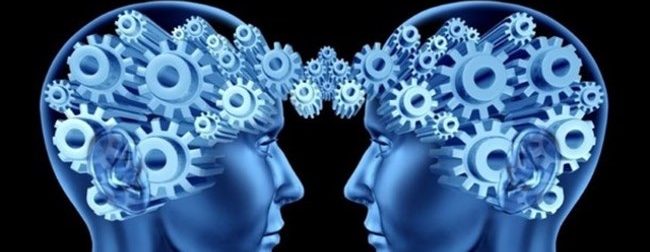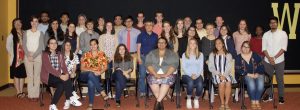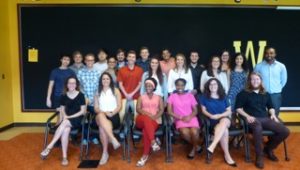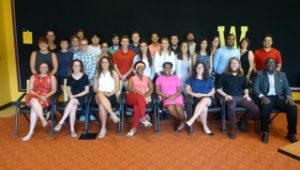NSF REU — Distributed Network of Neuroscience Scholars
This REU site is now closed. Our 3 years of NSF funding ended in 2018. There will be no further applications accepted.
Thank you for your interest and best of luck finding other great places to work!
A Distributed Network of Neuroscience Scholars
This Research Experience for Undergraduates (REU) Site award, funded by the National Science Foundation, to The College of Wooster, Wooster, OH, Kenyon College, Gambier, OH, and Earlham College, Richmond, IN will support 12-14 students for 9 weeks during the summers of 2016-2018, pending funding approval. Undergraduate participants (US Citizens or Permanent Residents only) will receive a stipend of $4,950 in addition to housing, meal and travel allowances. You must be a continuing undergraduate and a US Citizen or permanent resident to apply.
This REU unites the successful neuroscience undergraduate research programs of three predominately undergraduate institutions in Northern Ohio and Eastern Indiana. The REU consists of research teams from each institution, with no more than a 2:1 REU student to faculty ratio for a nine-week summer REU. Each group will focus on a separate research project from a faculty mentor’s area of expertise. Participants will work on challenging, authentic research questions and learn methods, skills and content to succeed in their research endeavors at their home institutions. In addition, during biweekly consortium meetings, participants will learn methods, skills and content on research methods being used at the partner institutions.
Participants will also engage in discussion on their projects, learn about the progress of their peers, network with other students, hear about career opportunities in academe and industry, develop ethical and responsible research conduct strategies and improve CV, cover letter and interview skills during the weekly consortium meetings that will bring the research groups together in-person and virtually. Students will present their findings at a research symposium at the conclusion of the program.
Here are the students that participated in our summer program during 2016:
Research themes associated with this REU span the breadth of Neuroscience include genetic model systems, neuromodulation, cellular responses to neurotrauma, rodent behavioral assessment, and cognitive and stress neuroscience. Participating labs are located in Biology, Chemistry, Physics and Psychology departments. A 3-day opening workshop will introduce students to the research themes, responsible conduct of research, mentoring, development of research plans, and data management.
It is anticipated that 8 students, primarily from schools with limited research opportunities, will join 8 students from the host institutions and participating faculty in a learning community focused on collaboration across the depth and breadth of Neuroscience. We are particularly interested in participants who are first-generation college students and those from groups that are typically underrepresented in science. Students will be selected based on their interest in research, academic record, and other factors. Students will learn how research is conducted, data are analyzed, and results are presented to both scientific and public audiences.
A common web-based assessment tool used by all REU programs funded by the Division of Biological Infrastructure (Directorate for Biological Sciences) will be used to determine the effectiveness of the program. Students will be tracked after the program in order to determine student career paths and asked to respond to an automatic email sent via the NSF reporting system.
DESCRIPTIONS OF 2018 RESEARCH MENTOR PROJECTS:
Faculty Mentor: David M. Barbella, PhD Earlham College
Analogy is the process of comparing a base case to a structurally similar target case. For example, in an analogy comparing the solar system to the Rutherford model of an atom, the sun is like the nucleus, the planets are like the electrons, and gravity is like electromagnetic force. This analogy works because the relationship between the elements of the base is the same as the relationship between the elements of the target. Analogical processing may support a variety of cognitive processes (Gentner, D., 2003), and explicit cross-domain analogy is used to support learning in instructional texts.
A machine reading system that can process through an analogy it encounters while reading text can improve its understanding of the material it reads, and potentially allow for insight into how humans handle textual analogy. However, detecting when the author is using an analogy is not easy, as written analogies take a variety of forms. Using modern machine learning, reasoning, and language processing techniques, we will look for ways to identify where in a text an author is using analogy with greater robustness and precision. We will also draw on what we know about how humans manage analogies.
Students working on this research will use a variety of text analysis tools and machine learning algorithms. No previous experience with specific tools or techniques is required, but students should have previous experience programming in Python. As there are several methodologies that show promise, students working on this research will have some freedom in terms of which strategies they wish to pursue.
Facutly Mentor: Andrew Engell, PhD Kenyon College
The Engell lab uses electroencephalography (EEG; aka “brainwaves”), event-related potentials (ERPs; a method for analyzing EEG data), and behavioral paradigms to investigate the “social brain”: those brain areas that support perception of socially relevant stimuli such as emotional face expressions, gaze shifts, biological motion, and underlying social competencies such as the inference of another’s goals and intentions. Face perception, a highly developed visual skill vital to typical social processing, represents an ideal model system for advancing our understanding of the social brain. The extremely complex processes that support face perception are belied by the speed and ease with which we detect and identify faces, read facial expressions, interpret gaze direction, etc. The Engell lab will investigate the nature and timing of the neural processes that make such complex tasks feel so effortless. Specifically, research this summer will focus on two ongoing projects. The first uses EEG to investigate what visual information is necessary for the brain to “know” it is looking at a familiar face. The second uses EEG and behavioral measures to investigate the non-conscious processing of faces. In other words, does your brain detect the presence of a face even when you are not consciously aware of seeing it? REU participants will contribute to these projects and gain experience in several aspects of cognitive neuroscience research, chief among them learning to acquire and analyze EEG/ERP data.
Faculty Mentor: Grit Herzmann, PhD College of Wooster
The Herzmann lab investigates the neural mechanisms of how humans are able to perceive faces, memorize visual material, and remember this material later on. The research focuses especially on cases of superior performance as found with own-race faces. Research shows that all people are better at learning and remembering faces from their own-race as compared to a different race. Understanding how perception and memory is improved for own-race faces can be translated into training programs for people suffering from learning disabilities or dementia. This year, our summer research will focus on data analysis, writing a literature review, and writing up results of previous studies. REU participants can also learn how to use event-related brain potentials (ERPs) to measure brain activation while participants perceive, memorize, and recognize faces.
Faculty Mentor: Seth Kelly, PhD College of Wooster
The Kelly lab aims to better understand the control of gene expression during nervous system development by focusing on how a family of RNA binding proteins regulates gene expression during axonal pathfinding and overall nervous system functioning. Mutations in ZC3H14, one member of this family, have been identified in a small number of intellectually disabled human patients. We began to investigate the function of the evolutionarily conserved Drosophila homolog of ZC3H14, called Nab2 that appears to be required for axon pathfinding in the fly CNS (Kelly, 2015). Projects in the lab will use immunofluorescence and other molecular techniques to further characterize pathfinding defects observed in Nab2 mutants and other pathfinding mutants in the lab. As a corollary to these projects, our lab is also interested in understanding how defects in pathfinding (in several different fly mutant strains) are related to changes in fly behaviors such as learning and memory, sleep, and circadian rhythm. In sum, these experiments should provide REU participants with strong training in the fields of neuroscience, cell biology, and genetics.
Faculty Mentor: Hewlet G. McFarlane, PhD Kenyon College
The McFarlane lab investigates behaviors in mouse models of mental illnesses and correlates these to the brain chemistry of the subjects. Most of the work is done in the BTBR T+tf/J mouse, an excellent model for autism (McFarlane et al., 2008) although other strains may be used. Current studies are focused on rescuing behavioral deficits observed in mice using pharmacological interventions. For example, ongoing studies in our lab have shown that learning and memory deficits in the BTBR T+tf/J mouse can be reversed through pharmacological treatments. REU participants will learn to use sophisticated automated systems (e.g., Noldus EthoVision, Observer, and PhenoTyper) to assess a wide variety of behaviors in mice. They will also use pharmacological treatments to assess the role of different neurotransmitter systems (e.g., GABA, Dopamine, Norepinephrine, Serotonin) in the behaviors observed and to attempt recue experiments.
Faculty Mentor: Robert Rosenberg, PhD Earlham College
In humans, spinal cord injury causes life-long paralysis. But when spinal cords of lamprey, a primitive vertebrate fish, are cut, the neurons recover from the injury, regrow, and reconnect. After approximately three months, the animals can swim almost normally again. The over-arching goal of this research is to determine the roles of ion channel expression during regeneration of lamprey spinal cord neurons. This line of research could contribute to new knowledge that eventually leads to improved treatment of devastating spinal cord injuries.
Our hypothesis is that expression of voltage-gated sodium and calcium channels is decreased in lamprey spinal cord neurons following spinal cord injury and expression of voltage-gated potassium channels is increased. Voltage-gated sodium and calcium channels are required for electrical and synaptic signaling in neurons (action potentials and neurotransmitter release), but excess activation can cause hyperexcitability and cell death. Voltage-gated potassium channels help repolarize neurons to the resting membrane potential after action potentials, and increased expression could help neurons remain inactive during a recovery period after injury. Preliminary evidence, from immunofluorescence microscopy (in which ion channels are labeled with specific antibodies and then visualized with fluorescent secondary antibodies), supports these hypotheses. In addition, we have preliminary evidence that chronic inhibition of sodium channels during the recovery period accelerates the recovery of swimming ability.
Students working on this project will learn techniques in small-animal survival surgery, spinal cord dissections, biological tissue fixation, cryosectioning, immunofluorescence labeling, fluorescence microscopy, image quantification, computational image analysis, and small-animal behavioral assays. Students will work together as a group while they learn the techniques, and then each student or pair of students will choose a sub-project to focus on for the remainder of the summer.
Faculty Mentor: Amy Jo Stavnezer, PhD College of Wooster
The Stavnezer lab is currently testing the impact of hormonal manipulations across the lifespan on the learning and memory in rodents. An exciting and still unanswered area of research surrounds the neurobehavioral and cellular influence of hormone replacement therapy on aged mothers. REU participants will be working with the data already collected related to this research question. We will run statistics and work on manuscript preparation, including reading, interpreting and discussing empirical research in the area. Applicants with strong writing and statistical skills will be given preference. In addition, the lab is taking on a new research challenge to assess the ability of frequency specific microcurrent as treatment in a rodent model of attention deficit disorder. The participants will run an experiment exposing young adolescent rats of both control and ADHD-type strains to microcurrent therapy and then test them in a combination of activity and nose-poke behaviors.
Faculty Mentor: Michelle T. Tong, PhD Earlham College
Cellular and neuronal processes, like synaptic plasticity and adult neurogenesis, have been extensively studied as mechanisms of long-term memory (LTM). The role of extra-neuronal mechanisms, like the extracellular matrix (ECM), in memory is less understood. The ECM has a well-established role in developmental plasticity, where it provides structural stability to neuronal networks and ends juvenile-like plasticity. The removal of ECMs in adulthood appears to re-open critical period-like plasticity. Perineuronal nets (PNNs) are specialized structures of the ECM which surround synapses onto the cell body and dendrites of neurons in the central nervous system. PNNs have recently been shown to play some role in memory in the adult brain. For example, the depletion of PNNs in the perirhinal cortex enhances long-term depression (LTD) and object recognition memory (Romberg et al., 2013, J Neurosci). However, there is still much left to be understood.
Previous research by the Tong Research Group focused on mapping the endogenous gene expression of PNN components (aggrecan, brevican, and neurocan) during olfactory perceptual learning. In Summer 2018, our team will determine whether this gene expression is a necessary mechanism of olfactory perceptual learning. Students will gain proficiency in designing and executing mouse behavioural protocols, brain tissue dissection and harvesting, mouse stereotaxic surgery, and quantitative polymerase chain reactions.
More information about the program by contacting the PI (Dr. Amy Jo Stavnezer at ajstavnezer@wooster.edu).



